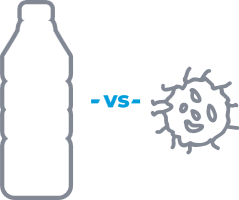Debunking PET Myths
There are some misleading beliefs and perceptions about PET plastics out there. We’re here to set the record straight.

Myth: It’s better to choose aluminum cans over PET bottles.
Fact: According to a 2010 cradle-to-grave cost analysis by Franklin Associates (a solid-waste management consulting group owned by Eastern Research Group, Inc.), PET plastic bottles use less energy, generate less solid waste and create significantly fewer greenhouse gases than aluminum cans.

Myth: PET plastics are bad for the environment.
Fact: PET plastics already have a low carbon footprint. But if just 200,000 people each recycled one more PET bottle per day, it would eliminate 2,168 tons of greenhouse gases. And because PET bottles are so recyclable, fewer end up in landfills.

Myth: PET plastic bottles are the most common form of litter.
Fact: Discarded cigarette butts are actually the world’s leading form of litter, followed by food containers and wrappers. Plastic bottles—all different types—are third. These, as well as aluminum cans and glass bottles, are just a few of the many forms of litter for which we all must take greater responsibility. But if more people were aware of PET’s 100% recyclability, they’d be less inclined to throw PET bottles away.

Myth: When I use a PET bottle, I’m contributing to ocean debris.
Fact: When you choose to recycle your PET bottle, you’re helping our planet. If you recycle right—in the recycling bin—your PET bottle can be recycled over and over again.

Myth: PET plastics can cause cancer.
Fact: Fact Untrue. There are no known links between PET and cancer of any kind.

Myth: PET bottles in landfills can leach into groundwater and contaminate it.
Fact: PET bottles are chemically inert, so they pose no risk of leaching or contamination.

Myth: It’s better to choose an aluminum can for my beverage than a bottle made of PET.
Fact: Beverage containers made from PET have a lower carbon footprint than their aluminum counterparts, when you compare the whole life cycle of the product (i.e., making, transporting, using the product). The carbon footprint of a beverage container made with recycled PET can be 15% to 50% lower than its aluminum counterpart.

Myth: I’ve heard that BPA is present in water bottles.
Fact: PET has never contained bisphenol-A (BPA), nor will it ever.

Myth: A bottle made of glass is just as rugged as a bottle made of PET.
Fact: PET is strong and lightweight—and unlike glass, will not shatter when dropped.

Myth: Boxed water is better for the environment.
Fact: According to the EPA, many mixed plastic and paper cartons do not get recycled, contributing to the 78 million tons of packaging waste in landfills, as of 2015. Also, boxed water and juices often come with plastic straws and have plastic liners. Water bottles made from PET are 100% recyclable, including the caps! PET is commonly used in food containers, due to its organoleptic properties, imparting no odor or taste in your food or beverage.